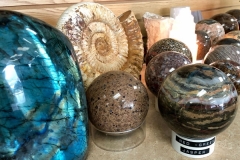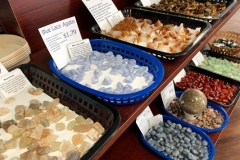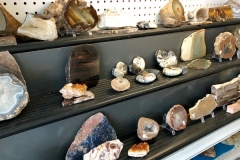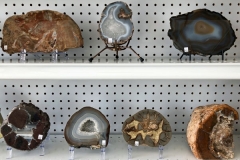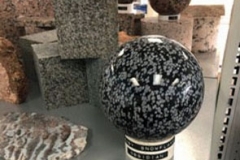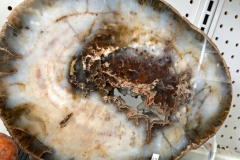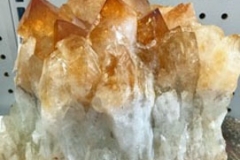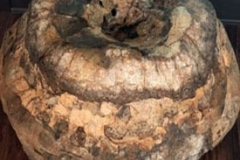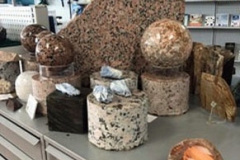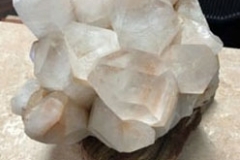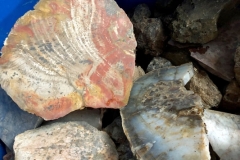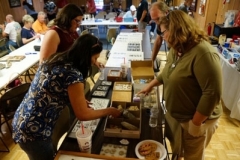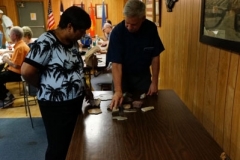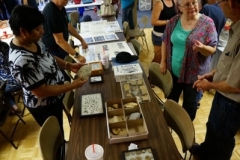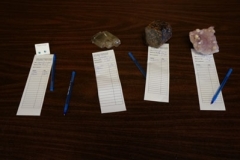Take a deep dive into one of geology’s most interesting minerals, Pyrite! Thank You to DGMS Member – Rich P. for sharing some fascinating facts and and pictures of Pyrite from his personal collection!
Pyrite
I pity the fool that mistakes Pyrite for Gold (like $1.00/oz. vs $1,800/oz.). But maybe I’m the fool, because I’m simply fascinated with “fool’s Gold”. How in the world can a mineral form a perfect cube in nature? Seems impossible, but it’s true, so I set out to figure out how this can be.

To start with the mineral Pyrite is iron sulfate with the chemical formula FeS2. So, what we’re looking at here is a single Iron atom bonded with two Sulfide atoms. This gives Pyrite the capability to form simple cuboidal crystals when all the environmental things are right. Every crystal has an orderly, internal pattern of atoms, with a distinctive way of locking new atoms into that pattern to repeat it again and again. The shape of the resulting crystal can be a cube, as in salt crystals or pyrite. I can’t follow all the chemical reaction that occurs, but I can tell you that some, not all Pyrite crystals are in the form of a perfect cube in nature. The one pictured above was not cut or shaped except by nature.
Pyrite is thought to be the most common of the sulfide minerals. So, you say, hard and stinky? Well not really. The name Pyrite comes from the Greek word pyr, “fire” because sparks can be made when you strike Pyrite with steel. So, in a way, because of my fascination with Pyrite you could call me a “pyritemaniac”! Ha! Well, maybe not. But I digress.
Pyrite is considered “the most harmful of all the minerals” according to Robert Finkelman a professor at UT Dallas. What! That’s right, professor Finkelman stated that “Pyrite binds arsenic in coal. When coal burns, Pyrite is oxidized thus releasing arsenic. For instance, the occupational lung disease of miners is caused by Pyrite. Pyrite is a main source of acid gases in the atmosphere.” So, what is Pyrite used for you ask? Pyrite is used in the production of sulfur dioxide, in applications like the paper industry and the manufacture of sulfuric acid.
If you are into metaphysical properties, you may want to go pick some up. According to energymuse.com:
“If you’re lacking motivation or physical strength, call on the Pyrite crystal meaning and reconnect to Mother Nature with this power stone that harnesses the earth element, the powerful energies that ground you and guide your spirit to a place of higher wisdom. If you’ re ready to take action to achieve your dreams and aspirations, be a rock star at meditation practice when you incorporate Pyrite and its divine guidance.”
But if you’re like me, then you just might like the mineral because of the way it looks and the way it forms a perfect cube in nature. But wait! There’s more.
As I’m sure many of you have seen, and like me, love a good “Pyrite Sun”, which is also known as “Miners Dollars”, “Pyrite Dollars”, or even “Sun Dollars”. But as stated on the illinoisstatemueum.com web site:

“..don’t call them fossils. They may look like fossilized plants, but the crystal structures actually formed deep underground under great pressure about 350 million years ago. These round disks sometimes occur between seams of coal and may be found when coal is mined. Although pyrite is quite common worldwide, the disk form is virtually unique to Illinois.”
I always just thought they were a pretty neat fossil, but they form naturally and that is really cool. But don’t get me wrong, in some fossil deposits Pyrite can be incorporated into bone, shells, or plant fossils during the process of fossilization. About a quarter way around the world, near England, is just one area where you can find some great Pyrite Ammonite fossils.

From Wikipedia.org: “Ammonoids are a group of extinct marine mollusc animals in the subclass Ammonoidea of the class Cephalopoda. These molluscs, commonly referred to as ammonites, are more closely related to living coleoids (i.e., octopuses, squid, and cuttlefish) than they are to shelled nautiloids such as the living Nautilus species.[1] The earliest ammonites appear during the Devonian, and the last species vanished in the Cretaceous–Paleogene extinction event.”
But as I stated in the beginning of this, maybe I’m the fool, because I’m simply fascinated with “fool’s Gold”. There are some really unique and crazy things associated with fool’s gold that make this one of the really cool minerals that I collect. Although, I am looking to a big chunk of “REAL” gold for my collection if you happen to have one cheap.
1. [1] Klug, Christian; Kröger, Björn; Vinther, Jakob; Fuchs, Dirk (August 2015). “Ancestry, Origin and Early Evolution of Ammonoids”. In Christian Klug; Dieter Korn; Kenneth De Baets; Isabelle Kruta; Royal H. Mapes (eds.). Ammonoid Paleobiology: From macroevolution to paleogeography. Topics in Geobiology 44. Springer. p. 3-24. doi:10.1007/978-94-017-9633-0_1.
Do you have a favorite mineral that you’d like to share with us?
Just let us know by writing up a short article & include some jpgs!
Email it to: dgms.sec@gmail.com


















